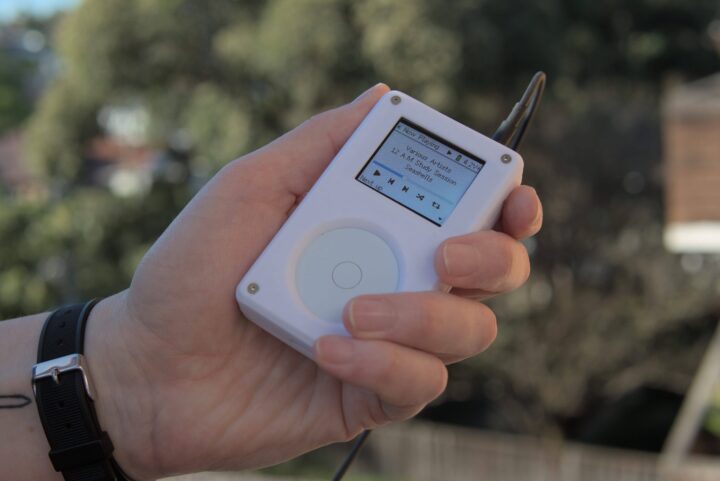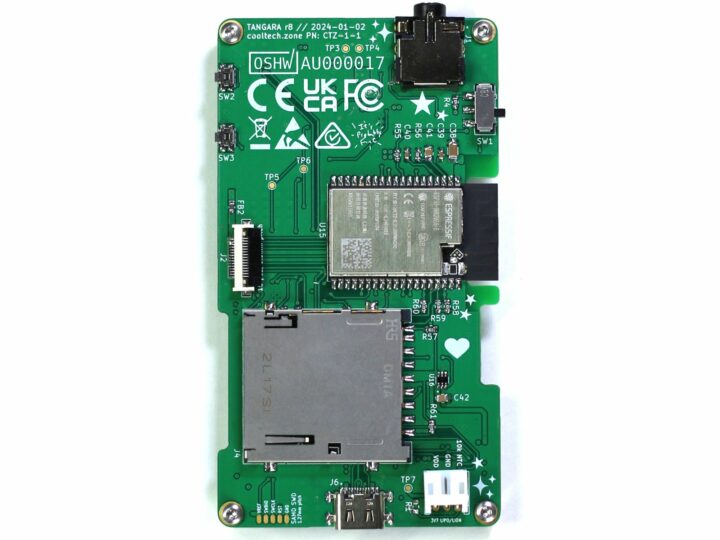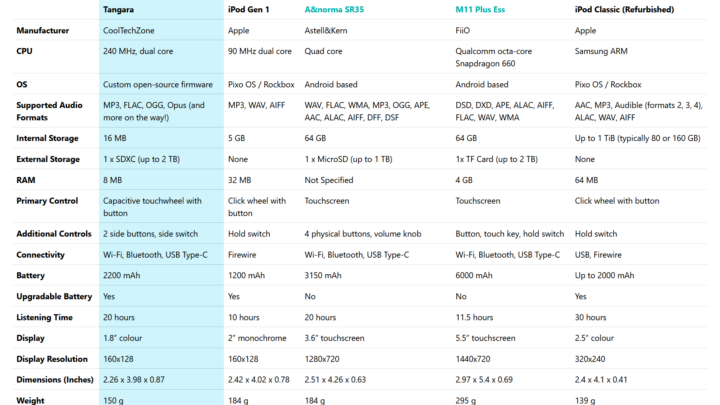Tangara is a portable music player that is out to make MP3 players cool again. With an iPod-inspired design and an ESP32 module at its core, Tangara presents an open-source and nostalgic way to listen to your favorite music and podcasts.
The ESP32-WROVER-E at the core of the music player is the main microcontroller but it also features a co-processor, a Microchip SAMD21, which is responsible for USB communication and power management. We have covered the ESP32-WROVER-KIT, a development kit for the ESP32-WROVER and ESP-WROOM-32 line of modules with a JTAG interface and an LCD. The Tangara music player can output audio through a 3.5mm headphone jack or Bluetooth, although Bluetooth is currently limited to the default SBC codec.
Tangara is the brainchild of Australian tech company Cool Tech Zone and is aimed at the portable media player community at large. This is reflected in many of the design choices made by the team. It has a full-color, 1.8″ display and can be controlled via the two side volume buttons and the large, capacitive touch wheel in the middle.
Tangara specifications:
- ESP32-WROVER-E wireless module
- SoC – Xtensa dual-core LX6 processor running at 240 MHz with 520KiB internal RAM
- Memory – 8MiB external SPI RAM
- Storage – 16MiB Quad SPI flash
- Co-processor – Microchip SAMD21E18 Arm Cortex-M0+ CPU @ 48 MHz, with 256KiB flash and 32KiB RAM
- Storage – Standard SDXC card, up to 2TiB
- Display – 1.8″, 160 x 128, full-colour TFT display
- Connectivity – Wi-Fi, USB Type-C, Bluetooth
- Audio
- WM8523 DAC and an INA1620 amplifier
- Current firmware supports 16-bit audio at 44.1 kHz or 48 kHz, DAC supports up to 24 bits and 192 kHz
- 1x 3.5 mm audio output
- Supports WAV, MP3, FLAC, Opus, and Vorbis codecs
- Bluetooth audio supported (SBC (sub-band) codec only currently. More codecs possible via firmware updates)
- Power
- 2200 mAh battery with a standard, 3-pin JST connector
- 1x USB Type-C charging, up to 1 A charge current
- Active battery life (typical) – 20 hours
- Standby battery life in years
- Buttons – 2x hardware buttons, 1x lock switch, and a configurable, capacitive touch wheel
- Misc – 1x ERM (Eccentric Rotating Mass) haptic motor for physical feedback
- Dimensions – 2.26 x 3.98 x 0.87 inches
- Weight – 150 grams
This project is completely open-source and the hardware, software, and firmware are hosted on sourcehut. This means that you can change and tweak any part of the device to suit your taste, and it is also easier to repair, compared to most alternatives. Documentation for the music player can be found on the cooltech.zone website.
The firmware is written in C++17 using ESP-IDF and uses a LevelDB-based database that imposes no limit on the number of tracks that can be stored. The entire UI is written in the Lua language and the international locale support lets you sort your collection according to your language of choice.
Tangara launched on CrowdSupply in early February and it has already blown past its funding goal. The music player is priced at $249 – cheaper than the iPod Gen 1 when it launched – and there is free shipping worldwide. Orders are expected to ship by September 2024.

Tomisin is a writer specializing in hardware product reviews, comparisons, and explainers. He is very passionate about small form factor and single-board computers.
Support CNX Software! Donate via cryptocurrencies, become a Patron on Patreon, or purchase goods on Amazon or Aliexpress








$249 for a music player? This is truly insane. I still use my Sansa Clip+ and it has served me well for many years since 2010. I also have another player that can also utilise Bluetooth and it only cost me £8, as well as one that did come with 128Gb internal storage that was only £50. The only thing that I want more of is for a player to be able to support greater storage (128Gb and above) via SD card. But I am not going to pay over $200 for this only real advantage of this model. There… Read more »
It is quite interesting that it basically loses in every item listed in the comparison sheet and is still priced that high.
hopefully rockbox will be ported to this so that someone can then make a cheap player using the same soc and take advantage of the port.
A user-replacable battery would have been nice too, it’s the law in the EU from 2027. Using the ubiquitous BL5C would have been a nice idea.
Sorry, it should be a typo, it’s $24.9
That’s the price, of course. I won’t believe how much it costs until some representative looks at my face and tells me it’s $249 without laughing. And then I will punch it sooo hard because that is sooo offensive 🙁
Pick up any low end phone, pop in a uSD card, install any music player app, done.
Features:
Seriously, a low end phone that will take a uSD card and allow you to install apps is like $20. And that’s new. Pick up something used. Or, now this is magical, use the phone you already have! Dedicated music player? What is this 2005?
Re: price tag
Consider just the electronics, go to a European parts supplier, check the price of the main components for a 100-500 production run, calculate total, estimate a decent margin
How much do you get?
Then add the rest of the hardware, the case design, extra costs… I won’t be getting one but I sure do understand the high price tag.
Question to Cooltech.zone if they happen to check here: why did you choose this codec?
Why are these comments so grumpy? It’s open source hardware. If the device interests you but their price is way too high, y’all can get together and clone it! Your gain. If it doesn’t interest you, well you’re just looking for something to complain about. You have lost nothing.
I personally think it’s very cute. I also can’t afford it. That’s ok. Breathe in. Exhale. The open source hardware hackers selling low-volume boutique products don’t look so scary anymore do they?
I have no interest in the device–original or ‘cloned’. A bad design is a bad design, it’s not going to be saved by being ‘open’.
Peddle your psychobabble elsewhere.
Keep sharing strong opinions on things you have no interest in! It really sets a tone.
And your commenting on something you have no involvement in says what, exactly? It tells me that you have nothing useful to contribute to the conversation, but simply want to throw sand into the gears of discourse. If you have something meaningful to contribute, please make yourself heard. If you simply want to impune the motives and knowledge of others, you’re failing horribly.
I appreciate that you’re new here, so you might want to read a bit more before commenting.
The code and the PCB looks good but that SAMD21 could be removed by swapping the ESP32 for an ESP32-S3, something which would also reduce the complexity of the firmware.
My thoughts as well. The design has all the hallmarks of a ‘lets just piece together bits until it has all we want’ without any sign of actual design knowledge thrown in. That said, I have not looked at their code nor the schematic.
The code was a bit of a headscratcher to grok but it’s quite well written and I like that the actual UI is coded in lua running on top of a custom C++ stack which is wrapping esp-idf (cleaner than the esp32-Arduino stack). When it’s done I’ll definitely be cribbing some of their ideas and implementations but that SAMD21 remains… vestigial.
The licenses directory is quite a bit to grok as well.
My first thought wasn’t the price, but the 16 MiB storage for the OS (inb4 get off my lawn comment). 8 MiB isn’t enough RAM to hold a large FLAC song entirely in memory, doubt that matters at all but complaining is fun.
That’s all the ESP32 can map into its address space at one time, so that’s the limit. You’re not going to be running ‘aps’ on something like this, so 16MB is actually plenty. Note that all the media will be stored on the uSD card and streamed in from there as needed. You don’t need to hold a whole song in memory to decode it, so that’s a non-issue.
I think 🤔 basic player, well I had my Sony nw 106 Walkman and my Fiio M7
Both look better than Tangara player
And sound really cool 😎
“Now there’s two of them!” https://hackaday.com/2024/02/12/melodio-self-mate/